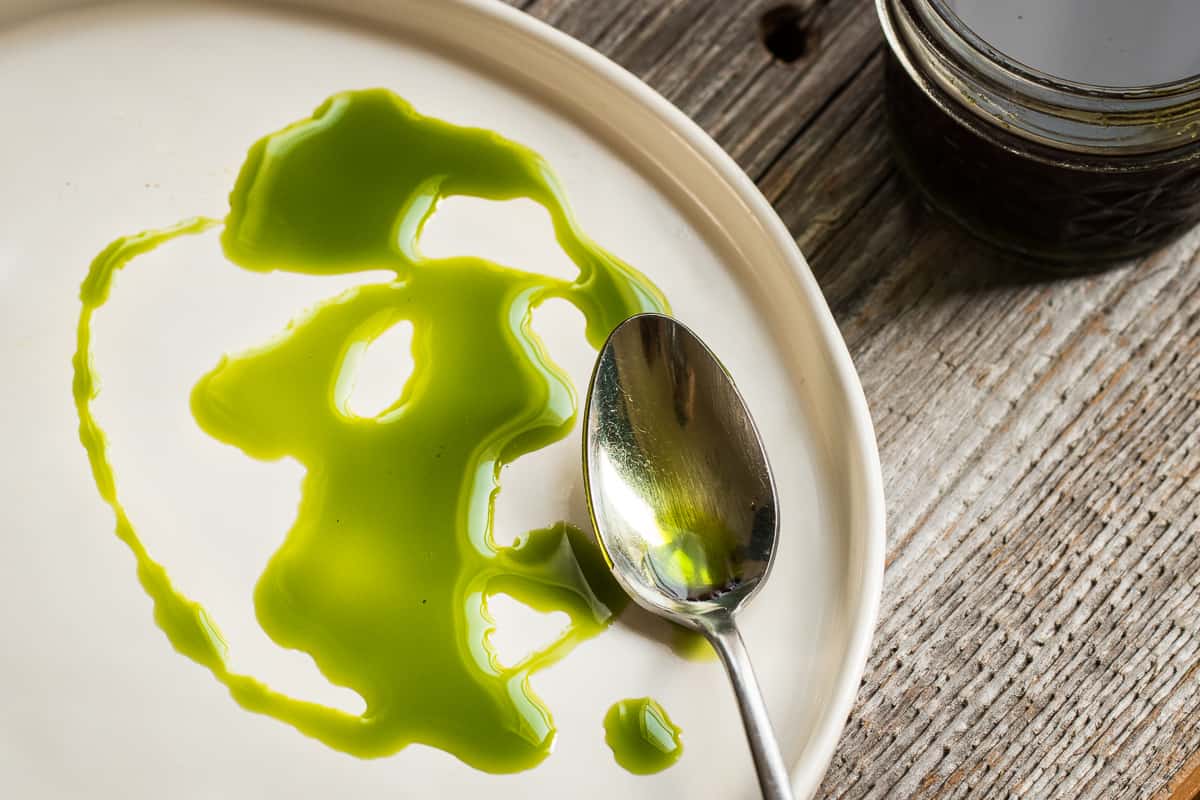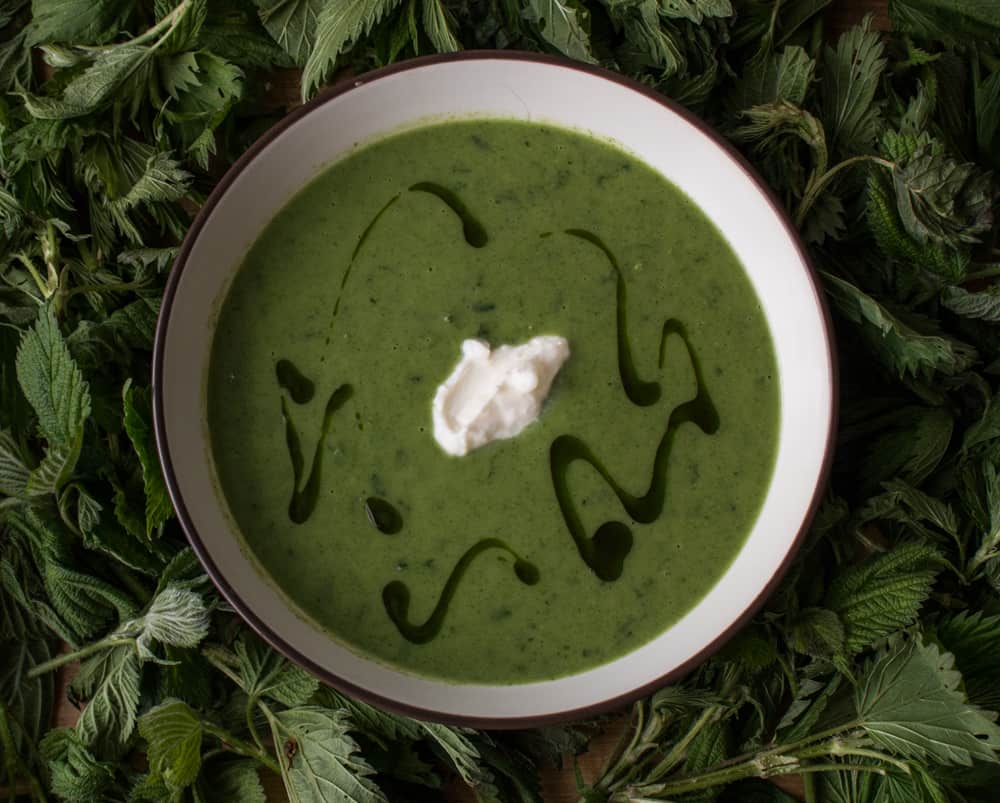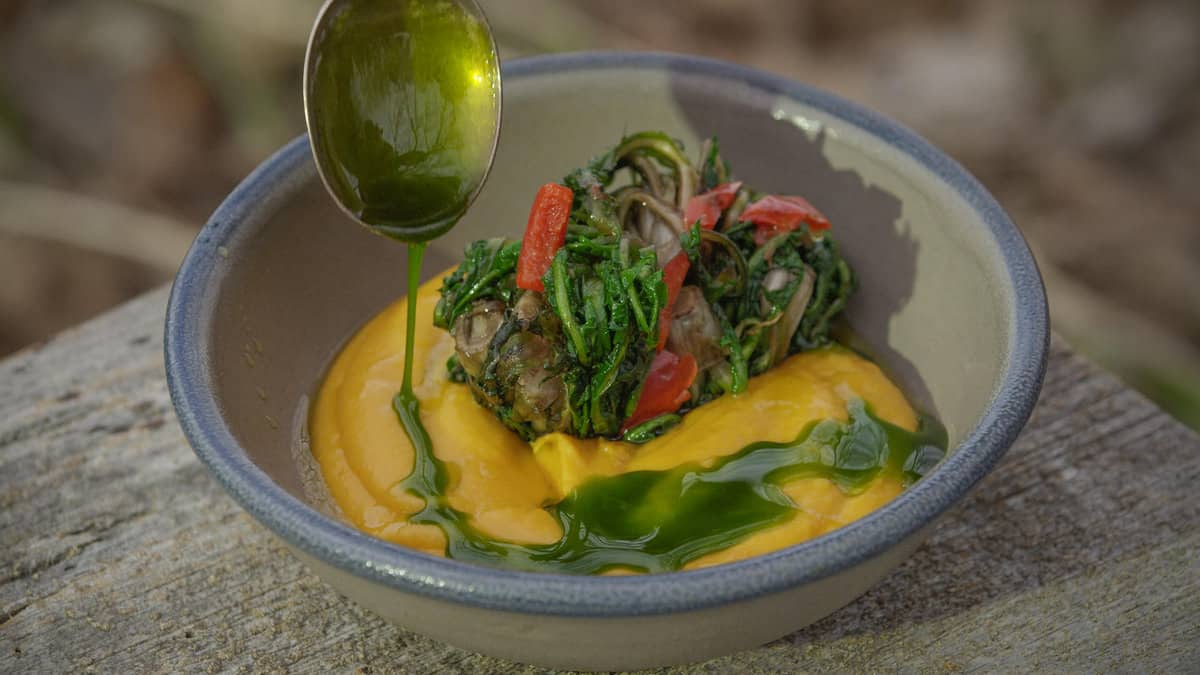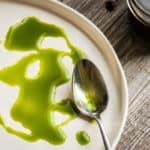Forest green, deep and oniony, chefs love a good green oil, and ramp leaf oil is probably the best I’ve ever had. It's a great way to preserve ramp greens. Most of the time, green oil can be a thoughtless garnish, or lazy drizzle on top of a soup—a little color—nothing more.

But with a little care, green oil is not only an impressive finish to a plate, especially soup, but it can have great flavor too, especially if it’s made with onion things.
For years I instructed cooks to make green oil with mundane things like blanched parsley or chives, and although they look pretty, they don’t taste like much. Blanching is good for locking in color, sure, but it also robs the ingredient of some of its flavor.

Blanching isn’t the only way to impart heat to things though, and blender can do the same thing after a little time, so that’s what I do here, and it’s the secret to having a green oil that both tastes and looks impressive.
Ramp leaves make one of the best, but any green onion my thing like chives, green garlic, or onion tops will be good too.

When the oil has flavor, all kinds of different possibilities open up, now, not only is the oil beautiful, but you can use it in dishes as a seasoning too. Here’s a few examples.
Use Ideas
- Anywhere you'd like oniony rampy flavor
- Use as a salad dressing, just toss the greens with oil, a dash of lemon or vinegar, salt and pepper
- Mix with lemon juice or vinegar and chopped herbs like tarragon or basil for a quick, light vinaigrette
- Mix into mayonnaise for an earthy, ramp kick
One of my personal favorites is mixing with reduced, warm cream, salt, pepper, and grated lemon zest, and drizzling over vegetables - Drizzle on soups, especially orange, white, or green
- Any dish with orange in it will benefit (see photo)
Safety Note
Since this is something I usually keep around for awhile, it *must* be refrigerated. Under refrigeration it's fine, and will last for up to a month, but do not let it sit out for weeks on end at room temperature, since there may be small particles of ramp leaves and water under the oil.
Without refrigeration, it can invite anaerobic bacteria. Don't let that scare you--just don't be careless--chefs make this all the time.
Ramp Leaf or Onion Top Oil
Equipment
- A good blender
- 1 Fine Strainer
Ingredients
- 6 oz about 3 cups green wild onion or ramp tops, chopped
- 1 ¼ cups mild tasting oil like grapeseed, sunflower, etc
- ½ teaspoon kosher salt
Instructions
- Combine all ingredients in a blender (preferably a vitamix) and puree on high for 60 seconds.
- Immediately pour the oil into a metal bowl sitting in another metal bowl filled with ice or cold water to chill it. Stir to reduce the heat, then cover and allow to chill overnight.
- The next day, strain the oil through cheesecloth, allowing it to drain naturally, and resisting the urge to press or squeeze out any oil, as water particles will pass through and give you a cloudy oil.
- Sometimes I allow it to drain overnight in the fridge if I have space, as you would yogurt or cheese. Store the finished oil in the fridge for up to a month.


Doug
I'm not sure I'll use this fast enough, and scaling it down probably won't work with the blender so empty. I guess I can freeze it.
Is the month-long shelf-life because the ramp leaves aren't cooked? I'm aware that blanching takes out the flavor. Have you tried steaming the ramp leaves (like you suggest in your nettles pesto recipe)? Also curious if steaming would prevent browning when making pesto.
Alan Bergo
Hey Doug, don’t pay too much attention to the 30 day shelf life. As long as you add the salt and keep it in the fridge it will be fine for a long time, and it can be frozen. It’s best to use the ramp leaves raw here-the blender actually cooks them a bit from the heat produced by the blades.
heather
Hi Alan,
Would this be freezable to preserve for a longer amount of time?
Alan Bergo
Yes that works well. Some people like to use ice cube trays.
Trent Blizzard
Hi Alan, as new residents of Wisconsin in the Springtime, we are collecting ramps. Trying out some of your recipes. Thanks as always. I had two questions:
1) in this recipe, you stress cooling down the oil rapidly on ice, can you speak to that a bit and why it is important to do it quickly? I liked your explanation of EVOO above in the same vein.
2) We also did your ramp butter recipe in your cookbook - and it calls for blanching half the ramps. Can you speak to why you blanch,and why only half of them? Based on the intro above, I am guessing that that locks in the color on 1/2 the ramps and the unblanched half is there to bring the flavor.
I figure there are some good food-basics behind these specific instructions and was hoping to understand the whys.
Trent
Alan Bergo
Trent, you cool down the oil to preserve the green color, and you use a metal bowl as it conducts hot and cold lightning fast, whereas plastic holds heat. Many chefs will blanch the greens for oil (chives are the most common) chilling them in ice water after to preserve the color, but this robs them of flavorful solutes that go into the water-not once, but twice. Essentially you're cooking the ramps gently in the blender, which explains the lengthy blending process.
You can probably get away with not putting the bowl in ice water, but I've learned from experience to account for user error here, which is why instructions can seem very specific. Leaving it for too long at room temperature can be problematic from a bacteria standpoint too. Chilling instantly drops the temperature to safe levels out of the danger zone. This is much more important for something that will be held in a fridge but doesn't have a low-pH, compared to a bundle of asparagus you're going to eat for dinner.
As for the ramps, that's correct. When I made it 10lbs or more at a time with all-raw leaves, we found some guests thought the flavor was too strong, so I started blanching half. Some people like to use them all raw-it's personal taste. Recently I added an extra ounce of raw and thought it was really good.
A
Kate
Would this work using olive oil? I'd prefer that as a drizzle on soups or (what I'm really thinking) pizza.
Alan Bergo
Kate, you can use olive oil, but the good EVOO will firm up in the fridge (the oil must be refrigerated) and will need to be melted to be able to be drizzled.
Jacqui
Yes, and I understand you discard the last bit of the oil in the bottom of the bowl to prevent having water and ramps bits moldering in the bottom of your bottle BUT "discard" can be employed differently.
I make this and then I save the smashed leaves from the strainer plus the bottom of the bowl stuff and freeze it either in small ziplocks or in glass jars. This is the base for marinade rubs for lamb roasts, for livening up a pasta sauce, for a multiplicity of purposes. It would be very sad to throw this out.
Alan Bergo
Yes, you can use the discard anywhere you'd use a green, oily, oniony puree.